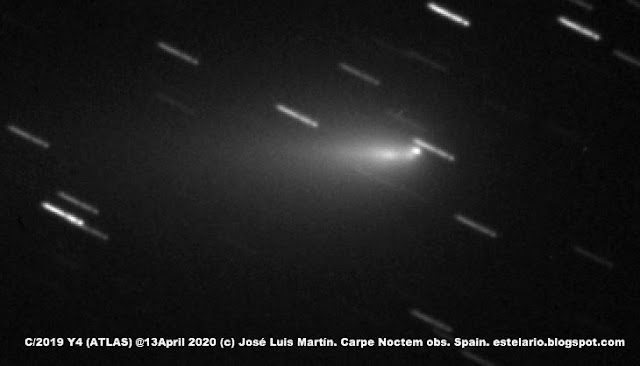Last night the Meteor Cam at the observatory detected +580 meteors corresponding to the Geminids. See the 580 images stacked into 1 single image below.
Sunday, December 13, 2020
Tuesday, November 17, 2020
Leonids meteor shower: while we sleep...
What happened last night above the observatory ?
Imagine we take a movie of the whole night sky, +12 hours, with a high sensitive camera and group in one single frame those moments when a meteor is detected by the camera. See the result:
 |
| Leonids 2020 trails detected during the night of 16-17 Nov. First light Meteor Cam at the observatory. |
In the above synthetic image, created by combining up-to 157 individual images in one single image, we can find more than150 trails. Most of them correspond to meteors and some fireballs (a firewall is not more than a meteor brighter than any of the planets). That is a meteor shower!
The bright arcs corresponds to the individual stars movement as the camera is fixed pointing to North West. Note the Polaris star trail, a small half circle in the top right of the image. Why half circle ?...
Monday, October 26, 2020
New Supernovae SN 2020uxz at NGC 514
Below two images of the Galaxy NGC 514 area.
- In the top image, a single 300s unfiltered capture acquired the Oct 23th 2020, marked in the center with a visual magnitud ~13.5, the Type Ia supernovae 2020 uxz. This type of supernovae are super energetic final destructive event for some stars resulting from the collapse of a white dwarf when it gets the Chandrasekhar limit and becomes unstable exploding violently. From here the star will evolve to either a black hole or more likely to a neutron star.
- Just below the previous one the much older image from (c) The Digitalized Sky Survey NIR released May 2019 database. Obviously both stars and galaxy are much more prominent since the professional instruments used are much more sensitive, but even in that case, there is no trace of any star at the supernovae position.
 |
| Before-After image comparision using Aladin Sky Atlas. |
 |
| Spectra of the Supernovae extracted using Star Analyzer 200 low res. grating and RSpec realtime spectroscopy software. |
Friday, July 31, 2020
El cometa C/2020 F3 (NEOWISE) el 20 de Julio
Saturday, May 30, 2020
Supernova en la galaxia M61 (2020jfo)
Para mas información, ver interesante artículo en la publicación de Sky & Telescope.
 |
| En la reciente imagen superior tomada desde el observatorio Carpe Noctem, se observa la brillante supernova, sin embargo en la inferior tomada anteriormente desde un observatorio profesional en Nuevo Méjico (SDSS) no se observa. |








